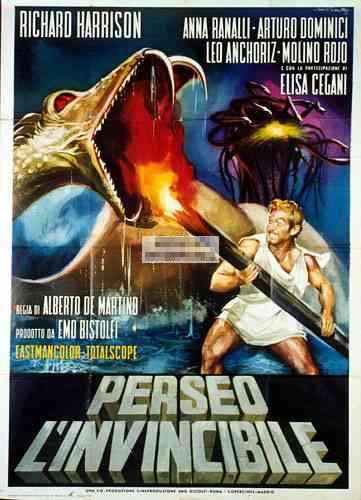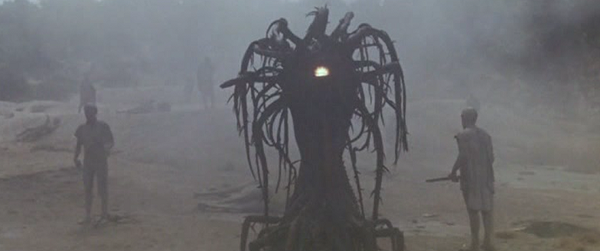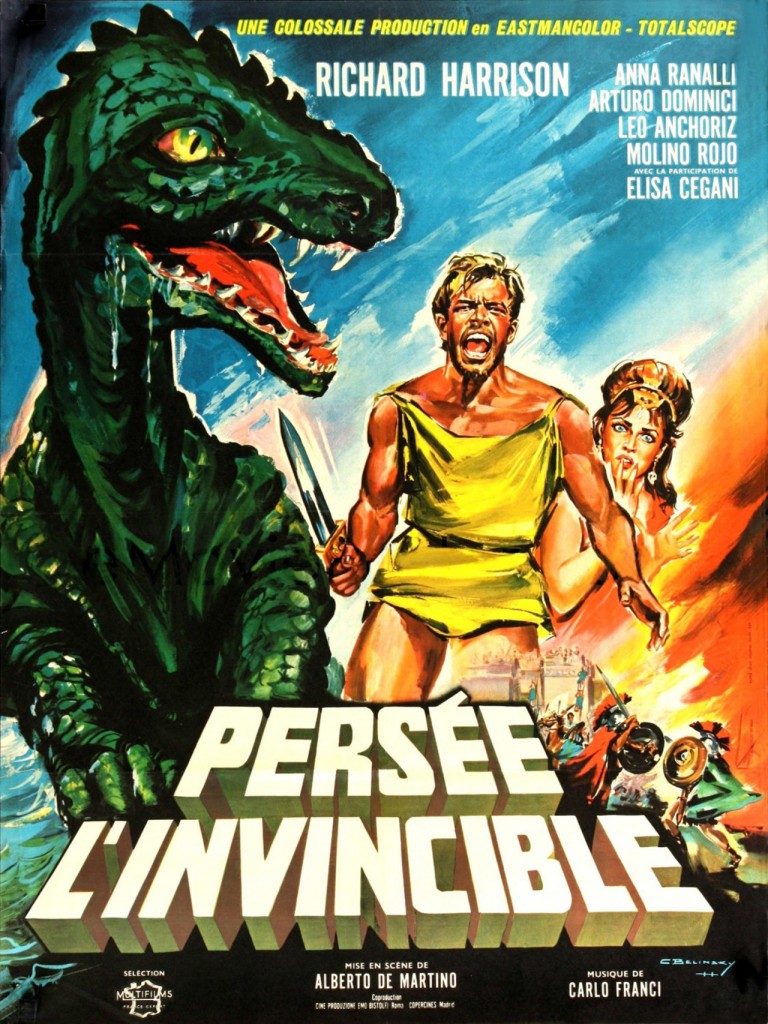Peplum Populist: Perseus the Invincible (Perseus Against the Monsters)
 The peplum film, a.k.a. the sword-and-sandal movie, was a dominant genre of Italian cinema from 1958 to 1965. Over a hundred pepla were produced, frequently in co-productions with other European countries, and often starring beefcake actors from the U.S. and U.K. like Steve Reeves, Reg Park, and Gordon Scott.
The peplum film, a.k.a. the sword-and-sandal movie, was a dominant genre of Italian cinema from 1958 to 1965. Over a hundred pepla were produced, frequently in co-productions with other European countries, and often starring beefcake actors from the U.S. and U.K. like Steve Reeves, Reg Park, and Gordon Scott.
Buried in this heap of musclemen action pictures and low-budget ancient costume dramas are a few fantasy treasures. Locating these gems of the fantastic is an occasionally, uhm, Herculean task because peplum films are poorly represented on home viewing options in English-speaking countries. You can find hordes of them on streaming services — 75% of Amazon Prime’s library seems to consist of public domain sword-and-sandal movies — but most are horrendous and unwatchable pan-and-scan transfers from prints faded almost to gray smudges. The same is true of the numerous budget pack DVD collections. Even the occasional prestige disc releases are often inferior.
So in this first of an occasional column excavating for the sword-and-sandal films the Black Gate readership may wish to sample, I’m glad to report that one of the most fantasy-heavy pepla, Perseus the Invincible, is available in a decent version from (who else?) Amazon Prime under one of its alternate titles, Perseus against the Monsters. Pepla often skimped on outright fantasy beasts in their mythological stories, but Perseus the Invincible delivers creatures from legendary special-effects designer Carlo Rambaldi. That alone makes it worth a look.
An Italian-Spanish co-production, Perseo l’invincibile was released in Italy in February 1963, just as the sword-and-sandal craze was poised to wind down and the Western was waiting in the wings to take over. It reached the U.S. on television as part of the “Sons of Hercules” Embassy Pictures syndication package, where it was retitled Medusa against the Son of Hercules. It’s also gone by the names Medusa vs. the Son of Hercules and Valley of the Stone Men. There are at least three different cuts in circulation: the original Italian version, the U.S. syndication cut, and a Spanish cut with additional special effects like laser eye beams from Medusa.
The screenplay plucks up bits and pieces of the Perseus myth, primarily character names and a few relationships, and fashions a plot that fits with the rituals of the peplum genre. The city of Seriphos (not an island in this version) has a problem with its rival city of Argos strangling the trade routes to the sea. Seriphos is forced to use a route through a valley where the danger of not one but two Carlo Rambaldi monsters — a lake dragon and the petrifying Medusa — make progress almost impossible. King Acrisius of Argos (Arturo Dominici) wants to forge an alliance with Seriphos by marrying King Cefeo’s daughter Andromeda (Anna Rannali) to his own son Galenor (Leo Anchóriz).
However, the true heir to the throne of Argos is young Perseus (Richard Harrison), who’s yet unaware of his parentage. Perseus already has the raging hots for Andromeda through a casual hunting acquaintance, although he doesn’t know who she is. Revelations occur, Perseus bests Galenor in an athletic competition for Andromeda’s hand, Galenor tries to kidnap Andromeda, and soon Argos is bringing a full-scale war down on Seriphos. Perseus leads his adopted city of Seriphos against the usurpers who rule Argos.
All this is mere detail and treated with the same sense of “convolution-to-no-point” that’s a hallmark of pepla screenplays. Audiences showed up for the spectacle of battle scenes, heroic contests of strength, and those Carlo Rambaldi monsters. Perseus the Invincible doesn’t fail when it comes to the latter.
 A few words first anent Signor Rambaldi for those who may be unfamiliar with his work. Rambaldi is the man who created E.T. for E.T.: The Extraterrestrial. He’s responsible for crafting the working xenomorph head in Alien. He built the animatronic Kong for the 1976 remake of King Kong. He constructed the sandworms for David Lynch’s Dune. And he brought to life the monster Dagoth in Conan the Destroyer. Whatever you may think of the second Arnold Schwarzenegger Conan movie, Dagoth isn’t one of its problems. Rambaldi won three Oscars during his career, and when he died in 2012 he left behind a prodigious body of work as a crafter of cinematic monsters.
A few words first anent Signor Rambaldi for those who may be unfamiliar with his work. Rambaldi is the man who created E.T. for E.T.: The Extraterrestrial. He’s responsible for crafting the working xenomorph head in Alien. He built the animatronic Kong for the 1976 remake of King Kong. He constructed the sandworms for David Lynch’s Dune. And he brought to life the monster Dagoth in Conan the Destroyer. Whatever you may think of the second Arnold Schwarzenegger Conan movie, Dagoth isn’t one of its problems. Rambaldi won three Oscars during his career, and when he died in 2012 he left behind a prodigious body of work as a crafter of cinematic monsters.
Rambaldi’s two creations for Perseus the Invincible are the lake dragon and a grotesque take on the Gorgon Medusa. Although Rambaldi obviously lacked the budget of a Spielberg film to manufacture his mythic marvels, what he manages under the constraints is still impressive. The lake dragon is capable of full emergence from the water, and the articulation of its head and eyes make it easy to suspend disbelief and take it as a real danger; it’s striking how much something as basic as eye movement can add to the overall effect. It’s leagues better than the papier mâché monster props often trotted out for other peplum films.
But Medusa is the movie’s star. Instead of going with a conventional design of a woman with snakes for hair, Rambaldi designed a gorgon resembling a crawling tree made of ropy, writhing serpent tendrils with an enormous single glowing eye. It’s a fantastic slice of nightmare, and easily the second best gorgon ever put on film. Ray Harryhausen’s Medusa from the original Clash of the Titans is the tops, of course, but Rambaldi buries the Clash of the Titans 2010 remake Medusa as well as the title monster from Hammer’s 1964 The Gorgon. Although The Gorgon is one of Hammer’s finest Gothic horror films, it was wise to keep its rather scruffy gorgon and her few immobile snakes off-screen as much as possible.
Perseus the Invincible doesn’t wait long to trot out its two monsters: both appear in the opening action sequence to whet audience’s appetite. They don’t reappear until the finale starts to close in, however. Perseus faces the dragon during a battle and then makes a dash to the valley of the petrified men, hoping that slaying the Medusa will restore the stone figures to life and provide him with the reinforcements he needs to defeat the army of Argos.
 In between Rambaldi’s creations, Perseus the Invincible is baseline sword-and-sandal stuff: a few haphazardly staged battles plus a requisite athletic challenge and duel scene. Bizarrely, there’s no ritual dance number, which was usually obligatory. Viewers who already have a liking for peplum action may find enjoyment here, but casual audiences will grow a touch restless; there isn’t enough variety of spectacle or scope of action to bolster the film during the mundane stretches, and none of the characters stand out. There are some effective matte paintings here and there, and you can always play the game of guessing what other eras the costumes were borrowed from, but that’s it.
In between Rambaldi’s creations, Perseus the Invincible is baseline sword-and-sandal stuff: a few haphazardly staged battles plus a requisite athletic challenge and duel scene. Bizarrely, there’s no ritual dance number, which was usually obligatory. Viewers who already have a liking for peplum action may find enjoyment here, but casual audiences will grow a touch restless; there isn’t enough variety of spectacle or scope of action to bolster the film during the mundane stretches, and none of the characters stand out. There are some effective matte paintings here and there, and you can always play the game of guessing what other eras the costumes were borrowed from, but that’s it.
There’s one pleasing bit of gratuitous violence seeded among the ho-hum action. During an archery contest, Galenor purposely shoots an arrow to hit and kill the soldier holding the target for him. There’s no real reason for it except as a piece of crunchy villainy. Too bad it has no effect on anything else in the movie.
Starring as Perseus is Richard Harrison, a Salt Lake City-born actor who did a few minor roles in Hollywood movies, such as a bit part in South Pacific. He relocated to Italy to partake in the peplum boom that needed U.S. performers to boost international sales. Harrison appeared in numerous sword-and-sandal flicks as a Steve Reeves replacement. The same year as Perseus the Invincible, he also starred in Gunfight at Red Sands, one of the foundational early Italian Westerns. Harrison continued to appear in a variety of Italian genre films for two more decades. He’s adequate as Perseus and nothing more. He stands out as strangely blonde and light-skinned among supposedly Greek characters played by Italian and Spanish actors. That he was dubbed by another actor in the English version doesn’t help. Richard Harrison is no Steve Reeves, that’s for sure. He’s not even Harry Hamlin. But Medusa is the one who brought you to the dance, and she’s fantastic. So most is forgiven.
The Amazon Prime streaming version of Perseus the Invincible, under the name Perseus Against the Monsters (the original U.K. release title), is one of the best presentations of a peplum available on the service. The dub is the “Sons of Hercules” version, complete with catchy song and a narrator explaining that (contrary to all classical sources) Perseus is a son of Hercules. But the print is an Italian one with the film’s original title. It’s an excellent quality print as well with hardly any damage. Instead of a terrible 4:3 crop job, the transfer takes up the whole 14:9 dimensions of a modern monitor.
Ah, but there’s a catch … there had to be one. Perseus the Invincible was shot in the Totalscope process with an aspect ratio 2.35:1, so squeezing this down to 1.78:1 means elongated images. This isn’t the ideal way to experience a movie, but I prefer this to slicing off more than a third of the image to accommodate a 4:3 pan-and-scan. The best I can say about the slightly stretched image is that you’ll soon get used to it. The Amazon version is at least watchable, and that’s uncommon with peplum presentations in North America.
Ryan Harvey is one of the original bloggers for Black Gate, starting in 2008. He received the Writers of the Future Award for his short story “An Acolyte of Black Spires,” and his stories “The Sorrowless Thief” and “Stand at Dubun-Geb” are available in Black Gate online fiction. A further Ahn-Tarqa adventure, “Farewell to Tyrn”, is currently available as an e-book. Ryan lives in Costa Mesa, California where he works as a professional writer for a marketing company. Occasionally, people ask him to talk about Godzilla on interviews.
I really, really enjoyed this one. Love the Lovecraftian gorgon and that amazing mechanical dragon that comes out of the lake!
@Robert – Yeah, brother, this one is definitely your type!
Some of my earliest memories are of watching THE MIGHTY SONS OF HERCULES on WDRB TV when I was about 5 or 6 years old and living in Radcliffe, Kentucky. As a kid I always wondered why the voice-overs didn’t match the actors’ lips most of the time–of course decades later I learned that the show was a melange of Italian-made movies (sword-and-sandal)–combined and English-dubbed to form a syndicated TV series. This was the same era (the 70s) when classic Shaw Brothers kung-fu movies were being translated and presented on BLACK BELT THEATRE every Sunday. Ah, memories.
Watching this on Amazon Streaming right now.
Loving it.
One thing that makes it extra-cool is that Perseus’ rival Galinor looks almost exactly like a Keegan Michael-Key character.
http://thumbs.picclick.com/00/s/MTIwMFgxNjAw/z/U7IAAOSwdzVXlA9e/$/16mm-Feature-Film-MEDUSA-VS-SON-OF-HERCULES-_1.jpg
@John – Wow, you’re right! Now I want a Key & Peele sketch set in a sword-and-sandal movie.